Star Wars: Galaxy of Adventures
Animating a masterpiece.
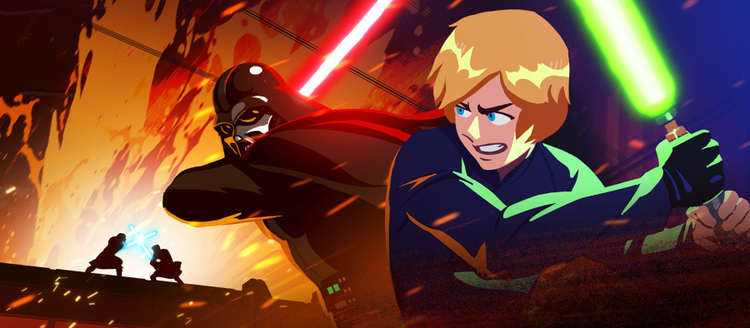
Star Wars! What else should I say!
We all grew up with it. It prompted us to dress up and speak like Darth Vader. It made us excited about space travel. Still young and still as exciting as ever! And when it came to doing an animated version of the series, Lucasfilm turned to Titmouse Inc., the premier animation studio based out of Los Angeles. I had a chance to interact with Barry J. Kelly and Mike Roush, the director and animation director of the show respectively. Here’s an extract of that interview.
How did this project materialize?
Barry: Titmouse made some shorts for Lucasfilm a few years ago leading up to “The Last Jedi.” They were really cute, fun shorts featuring BB-8. Lucasfilm was a really great creative partner, and the project went really well. They gave us a call when they were looking to do another line of animated shorts for their new “Galaxy of Adventures” brand, which consisted of toys and merch aimed at soon-to-be “Star Wars” fans.
I saw “Star Wars: Galaxy of Adventures” as a Saturday morning cartoon version of “Star Wars.” The challenge was to capture the energy of a world you want to escape to — and present it in 60 seconds, much like the main title sequence from a classic cartoon.
How did you decide on the specific look for this series?
Barry: “Star Wars” is everything — it’s funny, scary, uplifting, and more. So we needed a style that’s flexible to service all that encompasses the franchise.

Line weight is hard to manage. If you get too heavy on lines, the characters become stiff and rigid. if it gets too loose and round, it becomes hard to make the characters feel strong and constructed in cool action scenes. We decided to ditch the contour line to make the style a little more forgiving. Lines were used only for details within the character’s silhouette; we added light and shadow on a shot-by-shot basis. There were so many different characters and costume changes in “Star Wars.” Everything was constructed on a shot-by-shot basis.
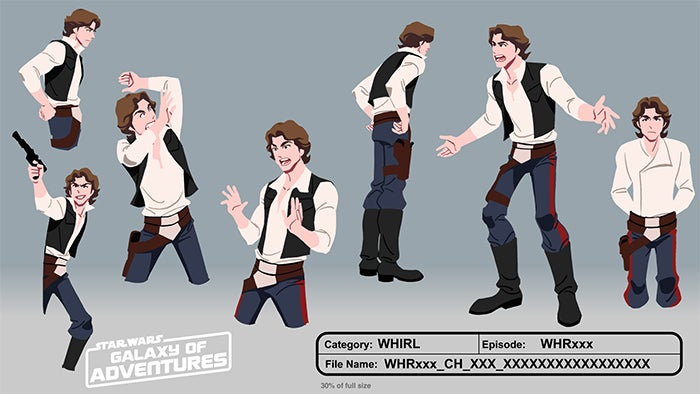
Mike: One of the great things about Adobe Animate is that we could choose any style we wanted for this project. The only restriction is one’s ability to think of something new and cool.
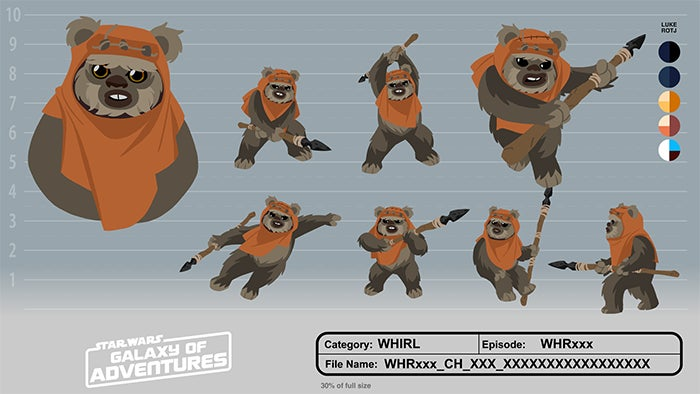
Here at Titmouse, we have tons of shows, and they all have unique and drastically different styles. Animate lets us do and go anywhere we feel like. We can’t let anything get in the way of what the client is asking for or what our artist can dream up. We love to make those “Fresh Styles.”
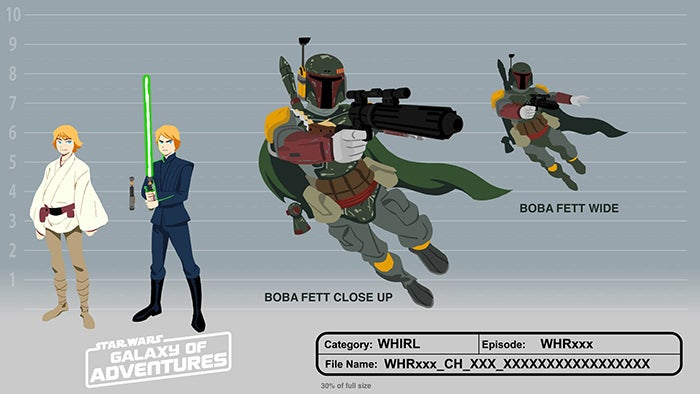
How did you achieve the specific look? Tell me a bit about the process involved.
Barry: Working in the Adobe family of products really helps streamline our process. Adobe Animate combined with Photoshop and After Effects is a really powerful animation toolset. It’s flexible and tried and true.
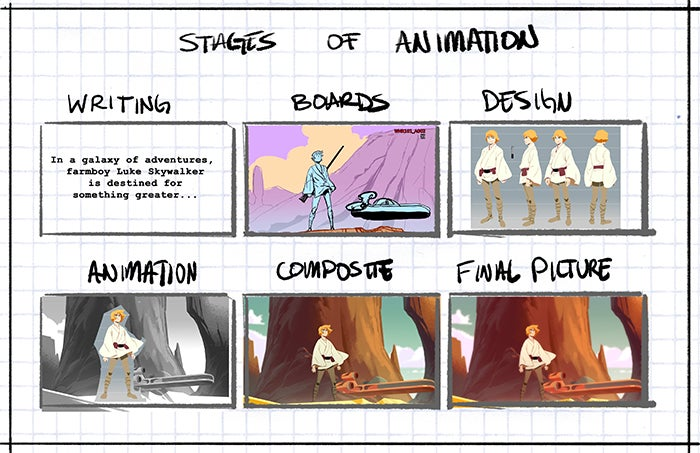
We animated the characters and effects in Adobe Animate. From the animatic, we’d break it up into individual shots and plug them into our template. Each shot .FLA is like a package that has the storyboard, character layout, background, and audio ready for an animator to take and bring a scene to life. Once the character animation was complete, we’d do an effects pass where our effects animator would add sparks, lasers, water, fire, etc. Symbol libraries were perfect for all the effects we’d reuse. Effects are typically done with matte shapes and colors which we would enhance in After Effects with color shifts, glows and blurs, etc.
Mike: Animate offers the speed and flexibility that is very important to productions with quick turnarounds. Being able to animate, do retakes, implement notes from the director and client without having to stop or slow down maximizes the creative input from our artists. Animate removes a lot of roadblocks and production red tape, and lets the artist jump right into creating. Animate doesn’t do the job of the artist, but it does create an environment where the artist can reach expectations, quickly.
That’s very interesting! Can you please walk us through the workflow and the timelines you work with?
Barry: I’m constantly going between Animate, Photoshop, and After Effects — switching my brain to each program’s functions. Starting from the first storyboard panel, I plan on how the shot will be composited, designed, and animated. I consider how each element is going to go to different departments, and come together again successfully (fingers crossed).
Production animation is like a big puzzle you build only to break it apart piece by piece. The pieces are all remade by artists and then you have put all these pieces back together again to make the cartoon. It’s stressful but also very fun.
Mike: From the animator’s perspective, the workflow is all about time management. An animator will get a shot with the audio, bg, and character design in an FLA. The animator will then have to rough pose, do breakdowns in between, add effects, clean, and color the shot in a day or two (on average). We work at a breakneck pace of about 8-10 seconds a week on some projects. This timeline is only possible if you have a strong toolset that lets the animator work without slowdown.
How has your experience been using Adobe tools? What are your plans in the near future?
**__**Mike: We see tremendous value using Adobe Animate and the greater Adobe family of products. In partnership with Adobe, we keep Animate growing and developing into an even stronger and more powerful tool. Together, we are working on tools that will push our abilities and make it even easier and faster to make the highest quality animated projects that push the art to areas that weren’t possible in the past. We are super excited to show our audiences what we have cooking.
Do you have advice to young artists aspiring to be a character animator?
Barry: My advice is simply to draw, draw, and draw some more. You don’t need to know how to draw everything, but you need to train yourself on how to approach drawing so you can draw anything — especially things you don’t understand, from an animal to a car, or understanding what makes an action or expression complete. It’s all types of problem-solving that comes with trying to convey your art and story clearly.
Mike: Do yourself a big favor and get a subscription to the Adobe suite. Get familiar with the software that is used in your artistic specialty, and you will immediately become more desirable to future employers. Adobe is the gold standard here at Titmouse. When I’m hiring animators the first question I ask is, “Do you know Adobe Animate?” If the artist has the abilities I’m looking for and if the answer is “Yes,” then I say, “Welcome to the team.”
Thank you very much. It was a pleasure talking with you.
Learn more about this series at these links:
https://www.youtube.com/starwarskids
https://lol.disney.com/star-wars-kids
You can get more information about all the wonderful things happening at Titmouse at these links:
https://www.instagram.com/titmouseinc/
https://www.facebook.com/titmouse.cartoons
https://twitter.com/titmouseinc
Please feel free to let me know your thoughts about this interview and any other interesting story related to Animate that we should feature. As always, you can reach me at _<ajshukla@adobe.com_>.